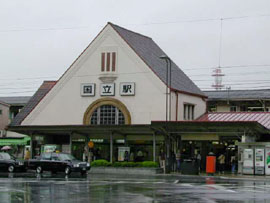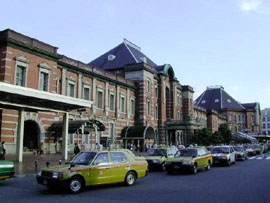Fleeing the Wrecking Ball: Tokyo's Historic
Buildings
Historic Tokyo Architecture
While shaking off the after effects of last night's conference with a bottle of shochu, an unforgiving hostess, and an angry taxi driver, I walked through the Hotel Okura's latest in its continuing series of art exhibitions held in its Akebono Room. It was a recent Sunday afternoon and this show was a part of Japan's ongoing celebration of its 400 years of relations with the Netherlands. By the half-way point, I had already viewed the women of Kees van Dongen, the angry reds of Karel Appel, the landscape works of Jacob van Ruisdael, and some token works of Van Gogh, De Kooning, and Rembrandt.
 Then I came to a full room of prints by M.C. Escher.
Then I came to a full room of prints by M.C. Escher.
"Now that building
is just impossible," I said when I saw the columns of
a work titled "Belvedere."
"That's because you're an addle-minded dolt," said a security guard sitting in a chair nearby. I turned and stared as he tipped his chair back on its rear legs and smirked.
At first, I assumed him to be a former taxi driver whose demeanor was not checked with his fare meter during the career change. But he was a foreigner, so an unlikely scenario. I chose to ignore him and moved to the next picture, "Hand with Reflecting Sphere."
As I gazed into the self-portrait, it hit me like yesterday's curry; the security guard was none other than Escher himself!
"So how about that one?" he said in rising from his seat and coming over to stand next to me.
"Has to be one of the ugliest mugs I have seen since I can remember. But at least I can make heads or tails of it." I smiled.
"Kid, not everything in this world needs to make sense. For example, why are historic national architectural treasures being demolished across Japan?"
"Progress?"
"Well," he said, shaking his head, "I think its time we take a tour of some of Tokyo's historic buildings. Some have been saved but others could lose a poker hand with the wrecking ball at any time. We can look at some of that potential 'progress' of yours in the making."
Like the Ghost of Architecture Past he directed me to the door.
Myonichikan (house of hope for the future) is one of the four remaining works in Japan of Frank Lloyd Wright. Located near Ikebukuro Station and buried amongst a large amount of housing complexes, is his 1921 creation for the Jiyu Gakuen Institute for Art and Craft Studies.
"The Dai-Ichi Kangyo Bank's clubhouse in Meguro Ward was demolished earlier this year and the Kojunsha clubhouse in Ginza is soon to meet its doom in the autumn, but this bit of history was saved." Escher waved his right hand. "It was recently given the status of important cultural property." He pointed to the 3-floored entrance section of the U-shaped structure.
In addition to its three floors, the entrance area features characteristics typical of a Wright design - jutting tiers, gently sloping roof sections, and generous amounts of windows. The remainder of the building varies from one to two floors as it extends around a small yard and parking lot.
"What is your opinion of the design?" I asked Escher.
"It's got open space within the building. I like it. But no spatial illusion."
"No gnomes walking around either."
"Yeah, well..."
"You can't win 'em all." I sympathized.
 Down the Yamanote Line about 15 minutes from Ikebukuro is Harajuku Station - the oldest wood station building in Tokyo.
Down the Yamanote Line about 15 minutes from Ikebukuro is Harajuku Station - the oldest wood station building in Tokyo.
"There are no plans for imminent demolition, but you never can be sure," said Escher. We stood and admired the structure from across the street in the middle of one of Tokyo's more trendy and fashionable areas.
The wooden part of the station is mainly the roof section and is more for ornamental purposes than structural necessity. The style gives the impression of a middle-European structure from the nineteenth century.
"Not much in the way of symmetry or repetition, but the sharp slope to the roof, dark trim, and central tower reminds me of home," reminisced Escher in tugging on his moustache. "What do you think, kid? Can there be any progress beyond this?"
"It's got a nice look to it. But maybe if giant ants drove the trains in a mobius pattern it would be better."
"Can't agree with you more."
We next headed west.
 About 40 minutes from Harajuku is Kunitachi Station on the Chuo Line. The dark red-roofed station building with half-monocle glass window in its center is the city's symbol.
About 40 minutes from Harajuku is Kunitachi Station on the Chuo Line. The dark red-roofed station building with half-monocle glass window in its center is the city's symbol.
"The Kunitachi Municipal Government is in the process of preserving this building. You see, the JR train company wants to reroute the line and demolish this building. It must be preserved. Just look at it!" exclaimed Escher.
Sort of resembling a gingerbread house, this second oldest wood station building in Tokyo seems to have stood by as the surge of modernization swept past. Its structural columns, though today covered by walls, are the same as the original construction. Additionally, its windows still carry the delicate ornamental features of the period in which the station opened - the 1920s.
"So what is the difficulty in saving the building?" I asked.
"Cash, kid."
Indeed he is right. The Yomiuri Shimbun reports, "The biggest obstacle to the preservation plan is the cost. (It is) estimated that between \150 million and \400 million would be needed, depending on the method."
"So are there any other buildings in Tokyo that have been saved?" I asked.
"Well I got one more story for you."
 Tokyo Station, in the heart of the city, was originally designed to be the single grand entrance for Tokyo.
Tokyo Station, in the heart of the city, was originally designed to be the single grand entrance for Tokyo.
"So now this, this is another success story," said Escher as we walked along the station's Marunouchi side.
Once again the old man knows what he is talking about. Look Japan reports, "Plans to demolish Tokyo Station's beautiful brick building because of its age and decrepitude met with fierce public opposition, resulting in a restoration project this year."
The station was originally designed by architect Tatsuno Kingo, based on that of the central station in Amsterdam. Built in 1914 with 3 stories and rebuilt in 1947 after WWII with 2 stories, the original 10,000 black pine pilings in the foundation are still in use today in supporting the brick and glass gateway to Tokyo. The dome ceilings destroyed in WWII were replaced during the reconstruction with octagonal-shaped domes modeled on the Pantheon in Rome.
As we stood near the plaque marking the location of the assassination of Prime Minister Takashi Hara in 1921, Escher said, "Did you know that this station is floating like a french fry in a hot tub of grease? Rising groundwater is pushing the foundation upward. It seems at any time it is going to set sail into Tokyo Bay."
"Jealous aren't you?"
"Yep, brilliant design. Wish I'd thought of it myself."
"But of course, you would have had lizards..."
"I would have had lizards crawling out of the windows, right."
As I turned away from the building to light my first smoke of the day, I said, "Say why don't we have a few drinks just down the road. I know a real friendly hostess..."
When I turned back, only the last day's light was shining on the wall. Escher was gone.
I blew two puffs of smoke into the air. They were merging spirals.

